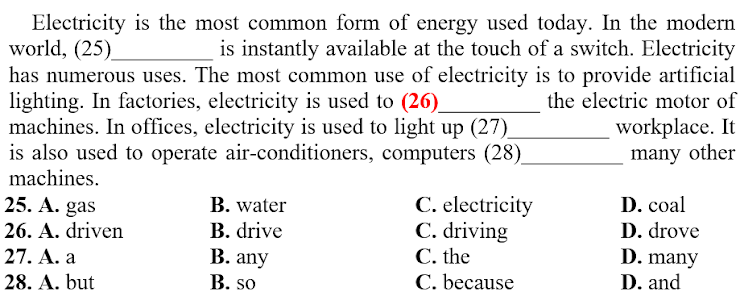Read the following passage and mark the letter A, B, C, or D on your answer sheet to indicate the correct word or phrase that best fits each of the numbered blanks from 25 to 29.
It is true that digital manufacturing does cut out the middle-man. More and more routine, repetitive assembly tasks will be taken (25)______ by machines. But as certain jobs disappear, new ones open up in other parts of the factory. Germany in many ways exemplifies this trend. Today, German manufacturers (26)______ three times more robots than U.S. companies, but they also still employ more humans. Relative to the size of our economies, German's manufacturing workforce is twice the size of America's.
From its very beginning, the fourth Industrial revolution has never presented manufacturers with an
either-or choice - robots or humans. It has always been about combining the talents of (27)______ . (28) ______, it is the convergence of artificial and human intelligence that will enable manufacturers to achieve a new era of speed, flexibility, efficiency and connectivity in the 21st century. Machines have the ability to assemble things faster than any human ever could, but humans possess the analytics, domain expertise and valuable knowledge (29)______ to solve problems and optimize factory floor production.
(Adapted from: http://time.com/4940374/joe-kaeser-siemens-robots-jobs/)
Điền vào ô 27.
A. ones
B.they
C. Both
D. two


C
Kiến thức: Từ vựng Giải thích:
ones: những (người, vật...) they: họ
both: cả hai two: số 2
From its very beginning, the fourth Industrial revolution has never presented manufacturers with an either-or choice - robots or humans. It has always been about combining the talents of (27) both.
Tạm dịch: Ngay từ khi bắt đầu, cuộc cách mạng công nghiệp lần thứ tư đã không bao giờ đưa ra cho các nhà sản xuất một lựa chọn hoặc - robot hoặc con người. Nó luôn luôn là về sự kết hợp tài năng của cả hai.
Chọn C